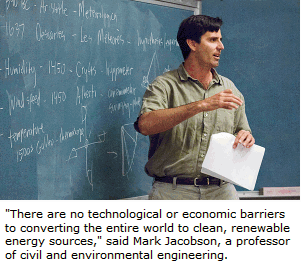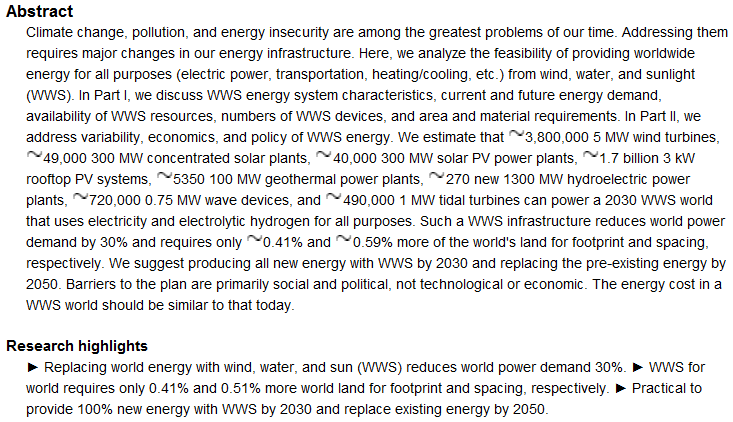|
|
|
|
|
|
|
News & Views item - February 2011 |
![]() Providing All Global Energy With Wind, Water, and Solar Power is Feasible Say
University of California & Stanford Researchers. (February 16, 2011)
Providing All Global Energy With Wind, Water, and Solar Power is Feasible Say
University of California & Stanford Researchers. (February 16, 2011)
A new study – co-authored by Stanford researcher Mark Z. Jacobson and UC-Davis researcher Mark A. Delucchi finds that converting the world's energy supplies to clean and sustainable sources can be accomplished with current technology at costs close to conventional energy. However Professor Jacobson and Dr Delucchi say that converting will be a massive undertaking on the scale of the moon landings requiring the societal and political will to make it happen.
 The
paper, Providing all global energy with wind, water, and solar power, Part
I: Technologies, energy resources, quantities and areas of infrastructure, and
materials is
available now online at a cost of US$20.
The
paper, Providing all global energy with wind, water, and solar power, Part
I: Technologies, energy resources, quantities and areas of infrastructure, and
materials is
available now online at a cost of US$20.
Interviewed by Louis Bergeron, Professor Jacobson, Stanford professor of civil and environmental engineering said: "It is a question of whether we have the societal and political will. Based on our findings, there are no technological or economic barriers to converting the entire world to clean, renewable energy sources." The researchers envision a world run largely on electricity. Their plan calls for using wind, water and solar energy to generate power, with wind and solar power contributing 90% of the needed energy. Geothermal and hydroelectric sources would each contribute about 4% in their plan (70% of the hydroelectric is already in place), with the remaining 2% from wave and tidal power.
According to Mr Bergeron: "Vehicles, ships and trains would be powered by
electricity and hydrogen fuel cells. Aircraft would run on liquid hydrogen.
Homes would be cooled and warmed with electric heaters – no more natural gas or
coal – and water would be preheated by the sun.
Commercial processes would be powered by electricity and hydrogen. In all cases,
the hydrogen would be produced from electricity. Thus, wind, water and sun would
power the world.
The researchers approached the conversion with the goal that by 2030, all new
energy generation would come from wind, water and solar, and by 2050, all
pre-existing energy production would be converted as well."
Professor Jacobson said: "We wanted to quantify what is necessary in order to replace all the current energy infrastructure – for all purposes – with a really clean and sustainable energy infrastructure within 20 to 40 years," and Jacobson and Delucchi find that as a consequence of converting combustion processes to electrical or hydrogen fuel cell processes a reduction of 30% in world energy demand would result. In short Professor Jacobson says: "When you actually account for all the costs to society – including medical costs – of the current fuel structure, the costs of our plan are relatively similar to what we have today."
In addressing the question of "base load" requirements for electrical energy Professor Jacobson says: "The most important thing is to combine renewable energy sources into a bundle. If you combine them as one commodity and use hydroelectric to fill in gaps, it is a lot easier to match demand." In addition he considers wind and solar to be complementary as wind often peaks at night and sunlight peaks during the day.
And Dr Delucchi noted: "One of the most promising methods of insuring that supply matches demand is using long-distance transmission to connect widely dispersed sites." Even if conditions are poor for wind or solar energy generation in one area on a given day, a few hundred miles away the winds could be blowing steadily and the sun shining, but he agreed that "with a system that is 100 % wind, water and solar, you can't use normal methods for matching supply and demand. You have to have what people call a supergrid, with long-distance transmission and really good management."
As to the matter of available materials to allow the manufacturing of the necessary equipment and infrastructure (see abstract below) they demonstrate that even materials such as platinum and the rare earth metals, the most obvious potential supply bottlenecks, are available in sufficient amounts. And recycling could effectively extend the supply.
"For solar cells there are different materials, but there are so many choices that if one becomes short, you can switch," Jacobson said. "Major materials for wind energy are concrete and steel and there is no shortage of those."
The authors also calculate that to power 100% of the world for all purposes from wind, water and solar resources, the footprint needed is about 0.4% of the world's land (mostly solar footprint) and the spacing between installations is another 0.6% of the world's land (mostly wind-turbine spacing), and according to Professor Jacobson: "The actual footprint required by wind turbines to power half the world's energy is less than the area of Manhattan." If half the wind farms were located offshore, a single Manhattan would suffice.
Finally Professor Jacobson told Mr Bergeron: "[I]t is possible to convert the entire world to clean, renewable energy sources without even having to go to new technologies. We really need to just decide collectively that this is the direction we want to head as a society."
